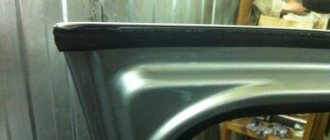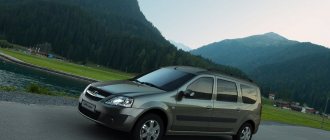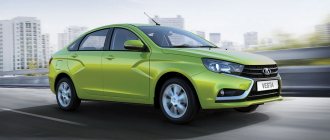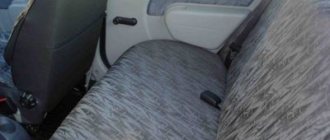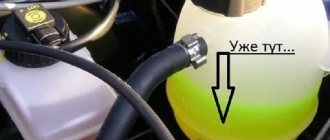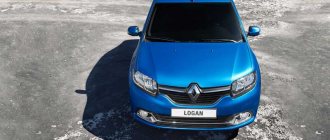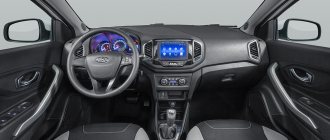When comparing B-class cars, which are designed for the average consumer, it is inappropriate to talk about prestige. Yes, outwardly they are no longer as “roughly” hewn as the first generations of Logans or AvtoVAZ cars, but they are still far from elegance.
Author of the article: Yaroslav Alchevsky 05/14/2020 0 0
Buying a new car is always accompanied by the agony of choice; you need to compare many parameters and calculate the benefits. Let's consider all the technical features of the Renault Logan and Lada Vesta cars; this will allow the future owner of the vehicle to approach the purchase more consciously.
Appearance
A comparative assessment of two cars should begin with the appearance; after all, it is this parameter that first of all catches the eye of both pedestrians and other drivers.
If we talk about Logan, the second generation looks much more attractive than its older brother (especially the restyling, which was presented in 2020 at the Dacia motor show). The lines of the body have become a little smoother, the optics have been made more modern, although otherwise the same strict forms of the first-born appear. There is a strong lack of style; the car is very simple in appearance.
Comparison of Lada Vesta and Renault Logan. Photo source: https://5koleso.ru/tests/lada-vesta-cross-protiv-renault-logan-stepway-sravnenie-byudzhetnyh-sedano-krossoverov/
The same cannot be said about the Lada Vesta; this time the AvtoVAZ product turned out to be more than worthy:
- expressive X-shaped grille;
- graceful flowing shapes on the outside of the doors;
- turn signal indicators on the side mirrors.
The car has a modern design feel, and according to most, it is a great option for young people.
It is interesting to watch a video comparing the Renault Logan Stepway or the Lada Vesta Cross, which are also presented in the same class.
Interior and prices
Renault Logan interior
The Lada Vesta is still prettier inside, although it cannot be said that the Renault Logan is deprived of beauty. After the change of generations, its extremely boring interior has become a thing of the past, giving way to an attractive and stylish design. The dashboard is small and neat, and the deep black color of the plastic combines surprisingly harmoniously with aluminum-look inserts and chrome trim on the dashboard. And shiny stripes around the air deflectors, the center console and in other places dilute the blackness.
The seats of the new Logan are noticeably more comfortable than those of its predecessor, which is especially noticeable by the high-quality padding and lateral support. The instrument cluster is simple and uncomplicated, but guarantees excellent readability, and the multimedia system will delight you with high-quality sound and prompt response to commands. There is enough space in the back, although it will frankly be cramped for three.
The quality of the Lada Vesta's interior is not inferior to the French one, but due to its more lively and interesting design it looks more advantageous. The impressive dashboard, with its deep wells, immediately sets the mood for drive, the multi-function steering wheel is very convenient, the dashboard floating towards the riders creates a feeling of massiveness, the seating is comfortable, and the ergonomics are in perfect order. There is plenty of space in the back, but the piled-up roof will make it difficult for tall passengers to fit comfortably. The luggage compartment of both models is worthy of respect - the Lada Vesta has 480 liters of usable volume, and the Renault Logan has 510 liters!
But Logan has a big advantage in price. Minimum cost 419,000 rub. versus RUB 514,000 - this is a big difference for the B segment. Of course, after the release of Vesta with an 87-horsepower engine, the price will be reduced, but obviously not to the level of Logan. However, Renault’s equipment is much poorer - the base does not have electronic security systems, steering wheel adjustments, amplifier only for an extra charge, etc. Prices in the top versions are 674,000 rubles. for Renault Logan and 658,000 rubles. for Lada Vesta. But this price tag is not final, since there are no Russian cars with a 114-horsepower power unit on sale yet. With it, Vesta will cost even more.
These car models are full-fledged competitors in the fight for attention. The cars are in the same price range and are distinguished by a high level of assembly and comfort.
Designers and people promoting their product claim that competitors meet all new standards and appear to be the standard of reliability. Let's try to find out which is better than the Lada Vesta or Renault Logan 2 for the Russian car enthusiast and consider the characteristics of power units, transmissions, appearance and interior. It is always difficult to choose, especially if the objects have many advantages.
In the fight between the Russian new product and the French car, a huge demand for both models is born, as manufacturers diligently adjust them to the climatic and road conditions of the Russian Federation. There is an obvious need to compare the Lada Vesta and Renault Logan 2. The second boasts sufficient endurance and ease of use, the first is modern, attractive and exciting. What to buy? This question is relevant for professionals and amateurs.
Interior comfort
If you look into the salon, you can highlight several important points that will also help the future owner in choosing:
- The front seats in the West are more ergonomic and more pleasant to sit on.
- In the Lada, the back row is equipped with hooks for clothes.
- Vesta is equipped with heated rear seats.
- The domestic car has advantages in cruise control (it is located on the steering wheel) and in installed light and rain sensors.
- The steering wheel rim in Logan is leather, while in Vesta it is plastic.
- Multimedia in the French car supports Android auto and Apple carplay.
- There is enough headroom for the rear passengers of the Renault to accommodate a large person.
Dimensions
A comparison of Renault Logan and Lada Vesta cars should be made in terms of dimensions. First, let's take a look at the dimensions of the domestic representative:
- length 4410 mm;
- width 1764 mm;
- height 1497 mm;
- ground clearance 178 mm;
- trunk volume 480 l;
- vehicle weight 1230 kg.
"Lada Vesta Cross". Photo source: https://versiya.info/avto/116533/amp
Now let's look at the French Renault Logan:
- length 4346 mm;
- width 1733 mm;
- height 1517 mm;
- ground clearance 155 mm;
- trunk volume 510 l;
- weight 1106 kg;
- The wheelbase of both cars is almost identical, the difference is 1 mm (2635 mm Vesta and 2634 mm Logan).
Renault gets a “winning point” only in terms of trunk volume and for a slight advantage in body height, while in other respects it is inferior to Lada.
Luggage racks
A little higher, the Frenchman’s advantage in trunk volume of 30 liters was indicated, but what is important to note:
- The hugely spacious Renault trunk has a small loading hole, which reduces its practicality.
- In "Lada" this point was worked out better, making this hole wider.
Otherwise, the trunks of these models are not very different and are unlikely to surprise future owners. If this department plays an important role in your choice and you want to get the most out of the trunk, then you can take a closer look at the Vesta SV Cross model, which has many storage organizers.
Specifications
The comparison cannot be called complete unless all technical parameters of the selected cars are considered. It is important to remember that the second generation Vesta or Logan are “workhorses” designed for quiet driving around the city and light off-road conditions.
Engines
The Frenchman presents two engine options:
- Standard 1.6 liter 8-valve engine producing 82 hp. Acceleration to hundreds is 11.9 seconds, top speed is 172 km/h.
- Atmospheric 16-valve engine, equipped with 102 hp. The speed limit has been increased to 180 km/h, and the acceleration time to 100 km/h has been reduced to 10.5 seconds.
Renault Logan Photo source: https://www.drive2.ru/l/9248720
The answer from AvtoVAZAa is presented only in the following options:
- Engine volume 1.6 l, power 106 hp. Acceleration to one hundred 11.8 seconds.
- 122-horsepower 1.8-liter engine. Its important advantage is power, which allows you to accelerate the car to hundreds in 10.2 seconds.
- Another configuration of Vesta is 113 horses with an AMT gearbox and a maximum speed of 182 km/h.
Gearboxes
Now let’s compare the Lada Vesta and Renault Logan in terms of operation and possible gearbox options:
- The domestic car, in addition to the proven and reliable 5-speed manual transmission, offers two models: with a CVT and an AMT (robot). What you can notice when using the AMT gearbox: when you start driving, the clutch may engage with a slight delay, but in a traffic jam it will not completely disengage, remaining in the “working” mode. Changing gears from first to second is accompanied by a noticeable hesitation. The CVT is more comfortable, there are no glitches when driving in the city, the only thing is that it lacks dynamics when overtaking.
- Logan is equipped with a CVT, four and five-speed automatic transmissions, and more understandable and confident mechanics. What you can pay attention to in a model with an automatic transmission: good response to the fuel supply when starting to move, the car takes off. There are also short delays during acceleration, when the gas is released, the speed drops, and the car takes time to react to the gas and accelerate.
Here the leader is difficult to identify; much depends on the preferences of the owner.
Chassis
The suspension design of the compared cars is almost the same: torsion beam in the rear and MacPherson strut in the front. But there is a noticeable difference in the settings of the same suspension, which manifest themselves in the control:
- "Vesta", having a high ground clearance, received a more energy-intensive suspension, and in addition to this, greater rolls and reduced vehicle controllability at high speeds. Small bumps on off-road roads are practically not felt up to certain speeds.
- The second generation Renault has a medium-stiff suspension with reduced roll when cornering. Among its main advantages, we can highlight the cost of the system; replacement of spare parts and their maintenance will cost the Logan owner no more than 40,000 rubles for a mileage of 100 thousand km. But if you drive it off a flat road, you will be pretty shaken.
Salon "Lada Vesta". Photo source: https://avtomarket.ru/stuff/user_upload/219592/219592_1024x683_kvcszg41vw.jpg
In any case, off-roading is equally not for these cars.
Fuel consumption
The car's appetite influences the decision when choosing a vehicle. But it is difficult to single out a clear leader on this point, since the only difference is between the Logan with an 8-valve engine and the Vesta, 9.8 l and 9.3 l, respectively. The “French” with a 102-horsepower engine has the same average consumption per 100 km as its younger brother.
Lada Vesta and Renault Fluence! Comparison.Review
Kassius
6 months ago Another comment from the owner of Fluence) I don’t want to call Vesta names, but I still won’t buy it. I'll try to explain. In the winter of 2020, we went intercity, along a busy highway (this is important, you will understand why later) in a brand new Vesta with a mileage of 12 or 13,000 km (I don’t remember exactly), it was cold - I remember that for sure) something about minus 20 degrees. We're driving fine, there's no sign of trouble, and suddenly the engine stalls... As we roll onto the cleared side of the road, a friend (he is the owner) tries to start the engine... The starter turns, but does not engage. A friend, an experienced car owner, suggested that the timing mechanism was damaged... In the end, it turned out that way. ON a new car, the tension roller broke and the belt flew off, the engine was 1.6 and in my opinion there were already grooves on the pistons and no disaster happened in terms of engine repair. But!!!! It’s good that this happened on a busy highway and thanks to the people we stopped and let them warm up in the cabin while they were waiting for the tow truck. What if it were on a highway where cars pass every 3 hours? Yes, of course, most likely we can call the traffic police and they will send a crew, so that we don’t freeze, we can also burn the spare tire... Now to my conclusions: could this happen to Fluence? I think that under certain conditions, yes, namely: when the owner does not comply with the regulations or bought a cheaper, counterfeit timing kit. And if everything is done according to the regulations on time and with high-quality spare parts, I have not heard of such problems with the timing belt. In Vesta, people regularly complain about such problems. A friend has a new car and a timing belt from the factory!!! Those. there is no need to talk about counterfeit products and such a fiasco!! After that, he stopped believing in this car and sold it. Why? Like me, he has a family and has children. It was JUST lucky that it wasn’t his children who were in the car, but two grown men, and it didn’t seem like there were any special problems for us. But if the car breaks down on the road in sub-zero temperatures with children in the cabin, that’s where the problems begin!!! I won’t describe everything so everyone will understand what I’m talking about. Moral: personally, I won’t buy a Vesta for one simple reason: it’s a matter of roulette and luck, whether you get a car with high-quality components and it won’t let you down on the road or something might happen to it at the most inopportune moment. I can’t rely on this from a car and be sure that it won’t fail at the right time!! Getting into my Fluence with a mileage of 150,000 km, to be honest, I don’t doubt it, although naturally, theoretically, it could break down, but it doesn’t do THAT!!! But I also service according to the regulations on originals purchased from a dealer. Expensive of course, but calm. In addition, Motrio spare parts just came out; they are cheaper, but the quality seems to be good too. Sorry for the many letters.
Feelings behind the wheel
To understand which is preferable to Lada Vesta or Renault Logan, you should compare them not in theory, but in practice. And it is better to carry out tests within the city, in traffic jams, with frequent braking and stopping, and also to drive along some off-road, country roads.
Around town
If we evaluate calm, measured driving around the city, then both cars will cope with this with a solid four: at low speeds and smooth roads without ruts, the movement will be confident. Vesta's high ground clearance allows it to overcome speed bumps and high curbs without problems. You can’t jump onto the curb on a Logan, except on a Stepway, which is made on its platform, but with increased ground clearance.
Off-road
Both cars are more designed for driving within the city, so driving them off-road is not the most attractive option, but it is quite acceptable:
- Vesta, again due to its ground clearance, can move over small uneven surfaces without problems at an average speed.
- Logan has a stiffer suspension, which increases the load on shock absorbers and silent blocks when driving off-road.
Vesta Cross or Logan Cross will cope with this test better; production of the former started in 2020, and the French Cross entered the market in 2020. These cars are designed for driving on unpaved areas, for long journeys and driving in snowy conditions. areas.
What's the end result? What to choose Lada Vesta or new Renault Logan?
Both cars presented in the review, Renault Logan and LADA Vesta, are undisputed leaders in their segment and are truly extremely popular among buyers in the Russian Federation. At the same time, the domestic model became the winner in many respects, but it’s up to you to decide what to choose.
If you put aside emotions, then only facts will remain that will help you determine which is better - Lada Vesta or Renault Logan 2. If we take equal prices, then Vesta will turn out to be more profitable - richer equipment, better control, more safety and even more powerful. If you take the TOP, it will also be cheaper. But Logan can also be upgraded to Vesta’s level, but this is an additional investment that will further increase the price gap.
Comfort and safety
After comparing handling, you need to evaluate the comfort and safety of the driver and passengers:
- Soundproofing in both options requires additional investment. The luggage compartment in the Logan is completely devoid of it, a felt covering on bare metal. As the owners of the cars being compared recommend, if you want to add a little more comfort while driving, it is better to immediately install anti-noise in the wheel arches.
- The seats are of medium hardness and a person can withstand a long trip without unnecessary stress.
Salon "Renault Logan". Photo source: https://yandex.ru/collections/card/5b56f2ee9136300086e0fadb/
According to the availability of security systems in Lada Vesta:
- ABS and ESP;
- driver and passenger airbags;
- hill start assistance system.
The Frenchman is deprived of ESP, although in other respects it repeats the configuration of the AvtoVAZ model.
Equipment and cost
The Vesta's configuration is superior to that of the Logan; it is equipped with four trim levels. The basic configuration of Logan is empty. You need to take it if you are really short on money. This configuration costs 419,000 rubles. Not enough for 2020.
Yes, this equipment is cheaper than the Lada Vesta in the base, this is due to the 8 valve engine. Top-end equipment, even higher than that of the Vesta. The price for Lada vesta ranges from 514,000 thousand to 633,000 rubles.
The basic logan we talked about starts at 419,000 and ends at 719,990 rubles. The Lada Vesta in the database is richer in configuration. In the base, the Lada has a lifting assistance system, abs, ebd, esc. The steering wheel is adjustable for reach and tilt. There is an electric power steering, Glonass era. a car of this configuration costs 490,000 rubles. A similar Frenchman will cost 540,000 rubles.
Options and prices
Perhaps one of the most important answers for many buyers to the question of which is better, Vesta or Renault Logan-2, is a price comparison.
Lada Vesta is presented on the market in several configurations (from Classic to Luxe Multimedia) and in the range from 636 to 947 thousand rubles. A model with air conditioning, a radio and a manual transmission will cost 704 thousand rubles, an AMT with the same equipment will cost 85 thousand more. The Luxe Prestige option with pre-maximum equipment costs 932 thousand rubles. The Exclusive package (heated rear seats, climate control, touchscreen multimedia) has a price of 964 thousand rubles.
Renault Logan offers three trim levels: the basic one with a 1.6L engine and 82 l/s costs from 625 thousand rubles, a 102-horsepower engine with an automatic transmission will cost from 779 thousand rubles, and the maximum equipment with the same engine will cost buyers 834 thousand . rubles.
Prices and options
Content
The Lada Vesta 2020 model year is presented in five versions: “Standard”, “Classic”, “Comfort”, “Luxe” and “Exclusive”, and the Renault Logan 2020 - in four: “Access”, “Life”, “Drive” and "Style". The most affordable Vesta “Standard” with a 1.6-liter engine (106 hp) and a 5-speed manual transmission costs 599,900 rubles, and the Logan “Access” with a 1.6-liter engine (82 hp). ) and a five-speed manual transmission - 569,000 rubles, that is, 30,900 rubles. (5%) cheaper. Both sedans are equipped with: driver's front airbag and ABS. The domestic model also received: a front passenger airbag, the Era-Glonass system and ESC dynamic stabilization, electric windows for the front doors, electric drive and heated side mirrors. The “Frenchman” has only “Era-Glonass” for 11,990 rubles as additional options for the “Access” package. In general, these cars can be safely called “empty”, but the “Russian” looks preferable, more than compensating for the high price with the installed equipment and a powerful engine.
Now let's compare the "budget" versions of sedans with automatic transmissions. You just need to clarify right away that the Lada is not equipped with a classic automatic transmission, but with a 5-speed robotic transmission. Lada Vesta “Classic” with the mandatory package of options “Start” 1.6 (106 hp) 5AMT costs 669,900 rubles, and Renault Logan “Life” 1.6 (102 hp) 4AT costs 724,990 rubles, that is, for 55,090 rubles. (8%) more expensive. Both models will delight future owners with the presence of air conditioning. As for the rest of the equipment, the “Frenchman” closes the gap from its rival, having received, in addition to the initial equipment, front electric windows and a second frontal airbag for the passenger. But the “Russian” also gets heated front seats and still offers a more competitive price.
Let's not dwell in detail on all the intermediate trim levels, but immediately compare the top versions of sedans. Lada Vesta “Exclusive” 1.8 (122 hp) 5AMT costs 874,400 rubles, and Renault Logan “Style” 1.6 (102 hp) 4AT costs 830,990 rubles, that is, 43,410 rubles. (5%) cheaper. The cars are equipped to the maximum, they now have: climate control, cruise control, rear electric windows, an audio system and front side airbags. But Vesta, unlike its rival, has Era-Glonass and a 7-inch touchscreen multimedia system with navigation. Adding their cost (11,990 rubles and 15,990 rubles, respectively) to the price of a French car, you get 858,970 rubles. And if we also take into account the less powerful engine of the “French”, the difference in cost will be minimal. Therefore, we can say that in the top versions the rivals have almost the same price tag.
